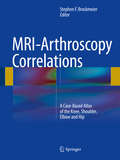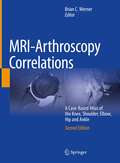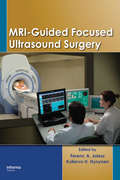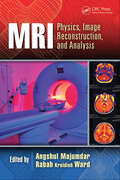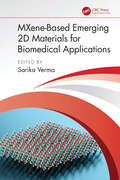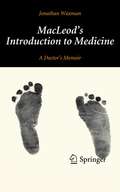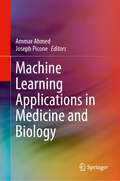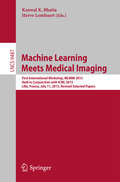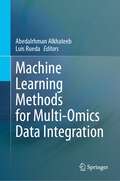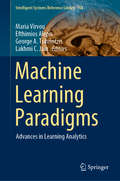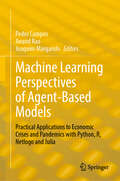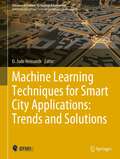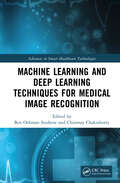- Table View
- List View
MRI-Arthroscopy Correlations
by Stephen F. BrockmeierIntegrating MRI findings associated with the spectrum of problems seen in the most commonly treated joints in sports medicine with the diagnostic findings seen during arthroscopy of the same joint in the same patient, this unique text correlates this pathology and applies these findings to the clinic, the radiology reading room and the operating suite. Representing a microcosm of daily patient care, this type of interactive correlation is an exceedingly effective tool for education and continued learning, an impetus for interdisciplinary research collaboration and a critical part of an approach to optimum patient care. Furthermore, this case-based correlation between MRI imaging and arthroscopic findings and treatment is a well-received and effective method for teaching and discussion at meetings and instructional courses. MRI-Arthroscopy Correlations is organized into four sections highlighting the four major joints in which MRI and arthroscopy are most commonly used in sports medicine: knee, shoulder, elbow and hip. Chapters are formatted to present an overview of the specific disease entity first, followed by selected cases chosen by the chapter authors that best illustrate common or noteworthy disease entities or pathology with an emphasis on the parallel MRI imaging and arthroscopic findings. Each of the section editors, as well as the volume editor, are nationally recognized experts, teachers and pioneers in their respective areas of sports medicine and have covered the gamut of topics in each of their sections. Taken together, this will be an invaluable resource for sports medicine specialists, orthopedic surgeons and musculoskeletal radiologists alike, promoting increasingly accurate diagnoses of pathology and advanced treatment options to aid in the optimization of patient care and recovery.
MRI-Arthroscopy Correlations: A Case-Based Atlas of the Knee, Shoulder, Elbow, Hip and Ankle
by Brian C. WernerIntegrating MRI findings associated with the spectrum of problems seen in the most commonly treated joints in sports medicine with the diagnostic findings seen during arthroscopy of the same joint in the same patient, this unique text correlates this pathology and applies these findings to the clinic, the radiology reading room and the operating suite. Representing a microcosm of daily patient care, this atlas of interactive correlation is an exceedingly effective tool for education and continued learning, an impetus for interdisciplinary research collaboration, and a critical part of an approach to optimum patient care. Furthermore, this case-based correlation between MRI imaging and arthroscopic findings and treatment has been a well-received and effective method for teaching and discussion at meetings and instructional courses.The second edition of this popular case atlas is organized into five sections highlighting the major joints in which MRI and arthroscopy are most commonly used in sports medicine: knee, shoulder, elbow, hip, and a brand new section on the ankle. Chapters have been reformatted to a consistent presentation, beginning with an overview of the specific disease entity and followed by selected cases chosen by the chapter authors that best illustrate common or noteworthy disease entities or pathology, with an emphasis on the parallel MRI imaging and arthroscopic findings. Throughout the text, updated arthroscopy images reflect current surgical techniques, many of which have changed significantly since the original edition was published. Authors and section editors, many new to this edition, are nationally recognized experts, teachers and pioneers in their respective areas of sports medicine and have covered the gamut of topics in each of their sections.Taken together, this will be an invaluable resource for sports medicine specialists, orthopedic surgeons and musculoskeletal radiologists alike, promoting increasingly accurate diagnoses of pathology and advanced treatment options to aid in the optimization of patient care and recovery.
MRI-Guided Focused Ultrasound Surgery
by Ferenc A. Jolesz Kullervo H. HynynenMRI-Guided Focused Ultrasound Surgery will be the first publication on this new technology, and will present a variety of current and future clinical applications in tumor ablation treatment. This source helps surgeons and specialists evaluate, analyze, and utilize MRI-guided focused ultrasound surgery - bridging the gap between phase 3 clinical tr
MRI-Negative Epilepsy
by Elson L. So Philippe RyvlinDrug-resistant epilepsy with negative MRI is frequently seen in patients considered for epilepsy surgery; however, clinical evaluation and surgical treatment is very complex and challenging. Advanced imaging techniques are needed to detect the location of the epileptogenic zone. In most cases, intracranial EEG recording is required to delineate the region of seizure onset - this carries some risks of major complications. Moreover, the borders between the recorded seizure onset and the location of important brain functions are often indistinct in MRI-negative epilepsy. Overall, the outcome of MRI-negative surgery is less favorable than that of MRI-positive surgery, but it can significantly improve with optimal management. Each chapter critically appraises the role and value of specific diagnostic and treatment techniques to address the challenges of MRI-negative epilepsy surgery. Authors critique evidence and share their expertise on the diagnostic options and surgical approaches that make epilepsy surgery possible and worthwhile in patients with this condition.
MRI: Essentials for Innovative Technologies
by Giuseppe PlacidiMRI: Essentials for Innovative Technologies describes novel methods to improve magnetic resonance imaging (MRI) beyond its current limitations. It proposes smart encoding methods and acquisition sequences to deal with frequency displacement due to residual static magnetic field inhomogeneity, motion, and undersampling. Requiring few or no hardware
MRI: Physics, Image Reconstruction, and Analysis (Devices, Circuits, and Systems)
by Krzysztof Iniewski Angshul Majumdar Rabab Kreidieh WardThe field of magnetic resonance imaging (MRI) has developed rapidly over the past decade, benefiting greatly from the newly developed framework of compressed sensing and its ability to drastically reduce MRI scan times. MRI: Physics, Image Reconstruction, and Analysis presents the latest research in MRI technology, emphasizing compressed sensing-based image reconstruction techniques. The book begins with a succinct introduction to the principles of MRI and then: Discusses the technology and applications of T1rho MRI Details the recovery of highly sampled functional MRIs Explains sparsity-based techniques for quantitative MRIs Describes multi-coil parallel MRI reconstruction techniques Examines off-line techniques in dynamic MRI reconstruction Explores advances in brain connectivity analysis using diffusion and functional MRIs Featuring chapters authored by field experts, MRI: Physics, Image Reconstruction, and Analysis delivers an authoritative and cutting-edge treatment of MRI reconstruction techniques. The book provides engineers, physicists, and graduate students with a comprehensive look at the state of the art of MRI.
MRI: The Basics (The\basics Ser.)
by Ray H. Hashemi Christopher J. Lisanti William BradleyConcise, readable, and engaging, MRI: The Basics, 4th Edition, offers an excellent introduction to the physics behind MR imaging. Clinically relevant coverage includes everything from basic principles and key math concepts to more advanced topics, including the latest MR techniques and optimum image creation. Hundreds of high-quality illustrations, board-style questions and answers, legible equations, and instructive diagrams take you from the basics of MR physics through current applications.
MRS of the Brain and Neurological Disorders
by Akihiro Igata Tetsuhiko Asakura Toshiro FujimotoMRS of the Brain and Neurological Disorders illustrates and demonstrates the usefulness of magnetic resonance spectroscopy for the diagnosis of brain and neurological disorders, including epilepsy, nervous disorders, psychiatric disorders, and brain tumors.The book is unique in that it contains 87 case studies of neurologic and psychiatric diso
MRSA
by John A. WeigeltResponding to the growing concern about the increased frequency and resistance of MRSA infections, this invaluable source analyzes the latest developments in the identification, assessment, and management of methicillin-resistant Staphylococcus aureus (MRSA) by leading authorities on the topic.
MRT-basierte Chirurgie des Rektumkarzinoms
by Martin E. Kreis Patrick AsbachIn systematischer Form und mit umfangreichem Bildmaterial führt dieses Buch in die Anwendung der MRT-Bildgebung in der Behandlung des Rektumkarzinoms ein. Chirurgen und Radiologen finden Antworten auf ihre wechselseitigen Fragen: Welche therapeutischen Schlüsse lassen sich aus den MRT-Befunden ableiten? Welche Informationen benötigen die Chirurgen bei der Planung des operativen Eingriffs? Welche Fragen kann der MRT-Befund beantworten und welche nicht? Die enge Kooperation beginnt beim Staging und reicht bis zur Therapieplanung beim Rezidiv des Rektumkarzinoms. Der konsequente Einsatz der MRT-Bildgebung erleichtert die differenzierte, auf den Patienten zugeschnittene Therapiewahl und wird das therapeutische Vorgehen beim Primär- und Rezidiveingriff revolutionieren.
MXene-Based Emerging 2D Materials for Biomedical Applications
by Sarika VermaThis book provides a well-focused and comprehensive overview of the history and background of MXene-based materials and their structure, synthesis, properties, and modifications for making various advanced materials. It covers in-depth processing parameters for making MXene-based materials for high-end applications, especially in the biomedical and pharmaceutical fields.MXene-Based Emerging 2D Materials for Biomedical Applications examines the use of MXenes in the healthcare sector as therapeutic agents in pharmaceuticals and medicine. The book examines MXene use in diagnosis and analysis as biosensors, disease detection, gene and drug delivery, cancer therapy, bioimaging, and graphen oxide (GO)-based antibacterial materials. It also discusses its potential as a promising antioxidant and GO-based scaffold for cell culture. It provides a comprehensive introduction of advanced MXene-based materials for the biomedical field/health sector through an interdisciplinary approach of research in science and biomedical engineering. The authors indicate possible areas wherein the advanced MXene-based emerging materials can benefit combining diagnostics and therapeutic possibilities and multiplex systems, and highlights the unique and novel approach to developing advanced medical applications platforms and state-of-the-art directions for future research.This book will guide bioengineering and material science students, scientists, and researchers to plan future research in this valuable field. It is a unique book that gives broad knowledge about MXene-based advanced materials under a single umbrella and demonstrates the usefulness of MXenes in the healthcare sector in multiple ways.
Ma Vie en Noir
by Daniel Pedro CardinaliI wrote this book urged by the overwhelming desire that arises towards the end of life to recapitulate the past. My goal was to summarize my experience of practicing science at the end of the 20th and early 21st centuries in Argentina, a country located far away from the world's leading scientific centers. In the book, I summarize the intricacies of the pineal gland ("the stone of madness") as historical, mystical and medical entity and its entry in contemporary medicine with the description of melatonin. I also reflect on how being associated with an unexplored subject at the beginning of their scientific career impacts the life of a scientist throughout their entire life. Today we know that in humans pineal melatonin begins is released every day late in the evening, and there is evidence that it is the trigger for the sleep process. But the most exciting aspect of melatonin is that it is a substance that is present in all living creatures, from unicellular organisms to plants and higher mammals, a fact that evinces its importance for life. Further, the neuroprotective action of melatonin promises to be crucial for the control of neurodegenerative diseases we face as a pandemic in this century. The discoverer of melatonin, Aaron Lerner, based its name on melano, the Greek word for black, because of its effect on the pigment cells of the skin. As in "La vie en rose", the immortal Edith Piaf song written in 1946, my lifelong work with melatonin could well be called "Ma vie en noir".
MacDonald's Atlas of Procedures in Neonatology
by Jayashree Ramasethu Suna SeoDetailed, step-by-step instructions and abundant full-color illustrations make MacDonald’s Atlas of Procedures in Neonatology, Sixth Edition, an indispensable resource in the neonatal intensive care nursery. This unique reference uses a practical outline format to present clear, easy-to-follow information on indications, preparation, technique, precautions, and how to avoid potential complications. New chapters, new procedural content, and new videos bring you fully up to date with current practice in the NICU.
MacLeod's Introduction to Medicine: A Doctor’s Memoir
by Jonathan Waxman'MacLeod's Introduction to Medicine: A Doctor's Memoir' is a collection of stories that gives the reader an insight into the humorous side of a doctor's life. There is a rich source of humor in medicine, and this book aims to share some of this.
Machine Learning Applications in Medicine and Biology
by Joseph Picone Ammar AhmedThis book combines selected papers from the 2022 IEEE Signal Processing in Medicine and Biology Symposium (IEEE SPMB) held at Temple University. The symposium presents multidisciplinary research in the life sciences. Topics covered include:Signal and image analysis (EEG, ECG, MRI)Machine learningData mining and classificationBig data resourcesApplications of particular interest at the 2022 symposium included digital pathology, computational biology, and quantum computing. The book features tutorials and examples of successful applications that will appeal to a wide range of professionals and researchers in signal processing, medicine, and biology.
Machine Learning Meets Medical Imaging
by Kanwal K. Bhatia Herve LombaertNormal 0 false false false EN-US X-NONE X-NONE /* Style Definitions */ table. MsoNormalTable {{mso-style-name:"Table Normal"; mso-tstyle-rowband-size:0; mso-tstyle-colband-size:0; mso-style-noshow:yes; mso-style-priority:99; mso-style-qformat:yes; mso-style-parent:""; mso-padding-alt:0in 5. 4pt 0in 5. 4pt; mso-para-margin:0in; mso-para-margin-bottom:. 0001pt; mso-pagination:widow-orphan; font-size:11. 0pt; font-family:"Calibri","sans-serif"; mso-ascii-font-family:Calibri; mso-ascii-theme-font:minor-latin; mso-fareast-font-family:"Times New Roman"; mso-fareast-theme-font:minor-fareast; mso-hansi-font-family:Calibri; mso-hansi-theme-font:minor-latin; mso-bidi-font-family:"Times New Roman"; mso-bidi-theme-font:minor-bidi;}}This book constitutes the revised selected papers of theFirst International Workshop on Machine Learning in Medical Imaging, MLMMI2015, held in July 2015 in Lille, France, in conjunction with the 32ndInternational Conference on Machine Learning, ICML 2015. The 10 papers presented in this volume were carefullyreviewed and selected for inclusion in the book. The papers communicate thespecific needs and nuances of medical imaging to the machine learning communitywhile exposing the medical imaging community to current trends in machinelearning.
Machine Learning Methods for Multi-Omics Data Integration
by Luis Rueda Abedalrhman AlkhateebThe advancement of biomedical engineering has enabled the generation of multi-omics data by developing high-throughput technologies, such as next-generation sequencing, mass spectrometry, and microarrays. Large-scale data sets for multiple omics platforms, including genomics, transcriptomics, proteomics, and metabolomics, have become more accessible and cost-effective over time. Integrating multi-omics data has become increasingly important in many research fields, such as bioinformatics, genomics, and systems biology. This integration allows researchers to understand complex interactions between biological molecules and pathways. It enables us to comprehensively understand complex biological systems, leading to new insights into disease mechanisms, drug discovery, and personalized medicine. Still, integrating various heterogeneous data types into a single learning model also comes with challenges. In this regard, learning algorithms have been vital in analyzing and integrating these large-scale heterogeneous data sets into one learning model. This book overviews the latest multi-omics technologies, machine learning techniques for data integration, and multi-omics databases for validation. It covers different types of learning for supervised and unsupervised learning techniques, including standard classifiers, deep learning, tensor factorization, ensemble learning, and clustering, among others. The book categorizes different levels of integrations, ranging from early, middle, or late-stage among multi-view models. The underlying models target different objectives, such as knowledge discovery, pattern recognition, disease-related biomarkers, and validation tools for multi-omics data. Finally, the book emphasizes practical applications and case studies, making it an essential resource for researchers and practitioners looking to apply machine learning to their multi-omics data sets. The book covers data preprocessing, feature selection, and model evaluation, providing readers with a practical guide to implementing machine learning techniques on various multi-omics data sets.
Machine Learning Methods in Biomedical Field: Computer-Aided Diagnostics, Healthcare and Biology Applications (Studies in Computational Intelligence #1218)
by Jorge Brieva Hiram Ponce Ernesto Moya-Albor Sandra L. Gomez-Coronel Diego Renza TorresThis book provides an in-depth exploration of machine learning techniques and their biomedical applications, particularly in developing intelligent computer-aided diagnostic systems, creating groundbreaking healthcare technologies, uncovering novel biological applications, and fostering sustainable health solutions.Integrating artificial intelligence, mathematical modeling, and emergent systems, this book highlights the profound impact of these advanced tools in not only enhancing problem-solving within the biomedical field but also in catalyzing the development of novel solutions.This book is a valuable resource for readers interested in understanding the revolutionary impact of novel machine learning methodologies on the biomedical landscape. Furthermore, it offers a blend of theory and practical applications for those interested in biomedical education and training, biology, medicine, and sustainable health development.
Machine Learning Paradigms: Artificial Immune Systems And Their Applications In Software Personalization (Intelligent Systems Reference Library #118)
by Lakhmi C. Jain Maria Virvou George A. Tsihrintzis Efthimios AlepisThis book presents recent machine learning paradigms and advances in learning analytics, an emerging research discipline concerned with the collection, advanced processing, and extraction of useful information from both educators’ and learners’ data with the goal of improving education and learning systems. In this context, internationally respected researchers present various aspects of learning analytics and selected application areas, including: <P><P> • Using learning analytics to measure student engagement, to quantify the learning experience and to facilitate self-regulation; <P><P> • Using learning analytics to predict student performance; <P><P> • Using learning analytics to create learning materials and educational courses; and <P><P> • Using learning analytics as a tool to support learners and educators in synchronous and asynchronous eLearning. <P><P> The book offers a valuable asset for professors, researchers, scientists, engineers and students of all disciplines. Extensive bibliographies at the end of each chapter guide readers to probe further into their application areas of interest.
Machine Learning Perspectives of Agent-Based Models: Practical Applications to Economic Crises and Pandemics with Python, R, Netlogo and Julia
by Pedro Campos Anand Rao Joaquim MargaridoThis book provides an overview of agent-based modeling (ABM) and multi-agent systems (MAS), emphasizing their significance in understanding complex economic systems, with a special focus on the emerging properties of heterogeneous agents that cannot be deduced from the characteristics of individual agents. ABM is highlighted as a powerful tool for studying economics, especially in the context of financial crises and pandemics, where traditional models, such as dynamic stochastic general equilibrium (DSGE) models, have proven inadequate. Containing numerous practical examples and applications with R, Python, Julia and Netlogo, the book explores how learning, particularly machine learning, can be integrated into multi-agent systems to enhance the adaptation and behavior of agents in dynamic environments. It compares different learning approaches, including game theory and artificial intelligence, highlighting the advantages of each in modeling economic phenomena.
Machine Learning Techniques for Smart City Applications: Trends and Solutions (Advances in Science, Technology & Innovation)
by D. Jude HemanthThis book discusses the application of different machine learning techniques to the sub-concepts of smart cities such as smart energy, transportation, waste management, health, infrastructure, etc. The focus of this book is to come up with innovative solutions in the above-mentioned issues with the purpose of alleviating the pressing needs of human society. This book includes content with practical examples which are easy to understand for readers. It also covers a multi-disciplinary field and, consequently, it benefits a wide readership including academics, researchers, and practitioners.
Machine Learning and Artificial Intelligence for Smart Systems in Engineering and Healthcare: Select Proceedings of FLAME 2024 (Lecture Notes in Electrical Engineering #1433)
by Anurag Singh Bhupendra Prakash Sharma Sofia Singh Bhudev Chandra DasThis book presents the select proceedings of the 4th Biennial International Conference on Future Learning Aspects for Mechanical Engineering (FLAME 2024). It covers the applications of machine learning (ML) and artificial intelligence (AI) in the development of smart systems, with a particular focus on engineering and healthcare applications. It provides a comprehensive overview of state-of-the-art techniques, methodologies, and practical implementations of ML and AI to address complex problems in these domains. The book covers theoretical foundations, recent advancements, and case studies demonstrating the impact of smart systems on improving efficiency, accuracy, and overall performance in engineering and healthcare and many other multidisciplinary fields of mechanical engineering. This book will be useful for scientists, engineers, researchers and professionals working in the allied fields of machine learning and artificial intelligence.
Machine Learning and Deep Learning Modeling and Algorithms with Applications in Medical and Health Care (Springer Series in Reliability Engineering)
by Hoang Pham Vinayakumar Ravi Prabhishek Singh Manoj DiwakarThis book explains medical image processing and analysis using deep learning algorithms to analyze medical data. It focuses on the latest achievements and developments in applying this analysis to medical imaging, clinical, and other healthcare applications. The book covers among other areas: Image acquisition and formation. Computer-aided diagnosis. Image classification. Feature extraction. Image enhancement/segmentation. Medical image processing issues such as segmentation, visualization, registration, and navigation may seem to be distinct, yet they are all intertwined in the process of resolving clinical bottlenecks. Using deep learning algorithms, researchers were able to achieve record-breaking performance and set the bar for future research. Due to the extensive quantity of medical imaging data of CT scan, ultrasound, and MRI, there is widespread use of machine learning, specifically deep learning, to discover specific patterns on such data. Such large data is well quantified by deep learning models. Deep learning is now being utilized, customized, and particularly developed for medical image analysis, as opposed to when it was first introduced to the community. Having learned more about the techniques, researchers have come up with innovative ideas for combining artificial intelligence (AI) with neural networks to solve difficult issues like medical image reconstruction. The key features of this book are: Machine learning and deep learning applications. Medical imaging applications. Feature extraction and analysis. Medical image classification, segmentation, recognition, and registration. Medical image analysis and enhancement. Handling medical image dataset.
Machine Learning and Deep Learning Techniques for Medical Image Recognition (Advances in Smart Healthcare Technologies)
by Ben Othman Soufiene and Chinmay ChakrabortyMachine Learning and Deep Learning Techniques for Medical Image Recognition comprehensively reviews deep learning-based algorithms in medical image analysis problems including medical image processing. It includes a detailed review of deep learning approaches for semantic object detection and segmentation in medical image computing and large-scale radiology database mining. A particular focus is placed on the application of convolutional neural networks with the theory and varied selection of techniques for semantic segmentation using deep learning principles in medical imaging supported by practical examples. Features: Offers important key aspects in the development and implementation of machine learning and deep learning approaches toward developing prediction tools and models and improving medical diagnosis Teaches how machine learning and deep learning algorithms are applied to a broad range of application areas, including chest X-ray, breast computer-aided detection, lung and chest, microscopy, and pathology Covers common research problems in medical image analysis and their challenges Focuses on aspects of deep learning and machine learning for combating COVID-19 Includes pertinent case studies This book is aimed at researchers and graduate students in computer engineering, artificial intelligence and machine learning, and biomedical imaging.
Machine Learning and Deep Learning Techniques for Medical Science (Artificial Intelligence (AI): Elementary to Advanced Practices)
by K. Gayathri DeviThe application of machine learning is growing exponentially into every branch of business and science, including medical science. This book presents the integration of machine learning (ML) and deep learning (DL) algorithms that can be applied in the healthcare sector to reduce the time required by doctors, radiologists, and other medical professionals for analyzing, predicting, and diagnosing the conditions with accurate results. The book offers important key aspects in the development and implementation of ML and DL approaches toward developing prediction tools and models and improving medical diagnosis. The contributors explore the recent trends, innovations, challenges, and solutions, as well as case studies of the applications of ML and DL in intelligent system-based disease diagnosis. The chapters also highlight the basics and the need for applying mathematical aspects with reference to the development of new medical models. Authors also explore ML and DL in relation to artificial intelligence (AI) prediction tools, the discovery of drugs, neuroscience, diagnosis in multiple imaging modalities, and pattern recognition approaches to functional magnetic resonance imaging images. This book is for students and researchers of computer science and engineering, electronics and communication engineering, and information technology; for biomedical engineering researchers, academicians, and educators; and for students and professionals in other areas of the healthcare sector. Presents key aspects in the development and the implementation of ML and DL approaches toward developing prediction tools, models, and improving medical diagnosis Discusses the recent trends, innovations, challenges, solutions, and applications of intelligent system-based disease diagnosis Examines DL theories, models, and tools to enhance health information systems Explores ML and DL in relation to AI prediction tools, discovery of drugs, neuroscience, and diagnosis in multiple imaging modalities Dr. K. Gayathri Devi is a Professor at the Department of Electronics and Communication Engineering, Dr. N.G.P Institute of Technology, Tamil Nadu, India. Dr. Kishore Balasubramanian is an Assistant Professor (Senior Scale) at the Department of EEE at Dr. Mahalingam College of Engineering & Technology, Tamil Nadu, India. Dr. Le Anh Ngoc is a Director of Swinburne Innovation Space and Professor in Swinburne University of Technology (Vietnam).
